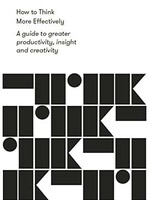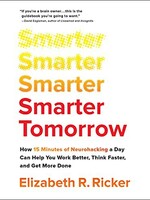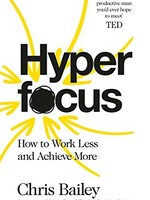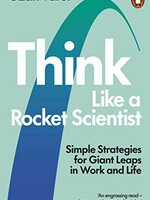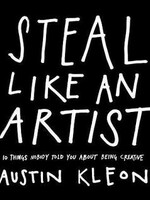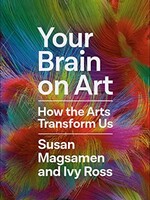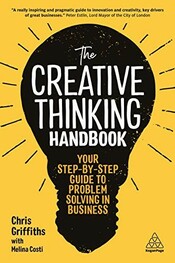
The Creative Thinking Handbook - Book Summary
Your Step-by-Step Guide to Problem Solving in Business
Release Date: November 12, 2023
Book Author: Chris Griffiths & Melina Costi
Categories: Creativity, Entrepreneurship, Career & Success
Release Date: November 12, 2023
Book Author: Chris Griffiths & Melina Costi
Categories: Creativity, Entrepreneurship, Career & Success
In this episode of 20 Minute Books, we delve into "The Creative Thinking Handbook" by Chris Griffiths and Melina Costi. Published in 2019, this book demystifies the concept of applying creativity to problem-solving in today's business and professional landscapes. It starts with a challenging premise - confronting the ingrained habits that thwart effective problem-solving.
Griffiths and Costi unravel a unique strategy for initiating creative thinking and maintaining its momentum, whether it's for a project, a business, or a career. But who are Chris Griffiths and Melina Costi? Griffiths is a recognized authority on creative thinking and innovation, working with Nobel Laureates, governments, as well as Fortune 500 and FTSE 100 companies. He is the mind behind OpenGenius, the creators of Ayoa - a mind mapping and project management tool with over two million users.
Melina Costi, on the other hand, is a seasoned business writer with a firm foundation in marketing management. She has co-authored "The Positive Leader" with former Microsoft Europe chairman Jan Mühlfeit, and along with Griffiths, their first collaborative effort, "Grasp the Solution", secured the second position on Amazon UK’s business chart in 2011.
"The Creative Thinking Handbook" is an essential read for those eager to elevate their creative problem-solving capabilities. It provides valuable insights for business leaders and managers desiring to foster a creativity-driven culture. Moreover, it offers practical strategies for those seeking to adapt and thrive in a constantly evolving world. This summary is published by arrangement with Kogan Page. So, stay tuned as we explore this compelling guide to creative thinking!
Are you ready to unlock the limitless potential of your creativity?
In the rapidly evolving landscape of our time, a familiar course of action doesn't guarantee success, or even stability, for businesses any longer. A study at the Yale School of Management suggests a startling possibility: by 2027, 75 percent of today's leading US firms will be replaced by entities that aren't even known to us yet. What this suggests is that our era, characterized by constant technological progress and shifting needs, calls for quick, flexible, and above all, creative thinking.
Yet, many are besieged by the belief that they lack creativity. Or they find themselves mired in work processes that stifle innovation, quashing any opportunity for fresh perspectives and groundbreaking ideas. This is the scenario we intend to transform.
Our discussion will equip you with the knowledge to harness and apply your creativity for problem-solving. You will acquire deeper insights into your thought processes, learn how to tackle obstacles in a systematic manner, and gather effective strategies to make creative thinking a fundamental aspect of your work.
By the end of our journey, you will know:
- How a single, seemingly insignificant word can hold the solution to your problem.
- Why your brainstorming sessions fail to generate the expected deluge of ideas.
- How your emotional responses can fuel your creative endeavors.
Let's understand the art of thinking strategically to kindle creativity.
The norm for most of us is to begin our day steeped in routine. We rouse from sleep and proceed with the everyday tasks that prepare us for the day ahead, almost like clockwork, without bestowing much thought upon it.
This automated sequence of actions owes itself to the efficiency of our brains. Our brains are adept at identifying repeated patterns in our thought processes, storing them for future use, and reverting to these patterns as and when required. Such ingrained patterns of thought are immensely useful for mundane, day-to-day activities like brushing our teeth or brewing our morning coffee. However, when it's time to tap into our creativity, these preset patterns can be an impediment.
When confronted with a novel problem, our routine thought processes tend to churn out solutions that are lackluster and devoid of creativity. To truly embrace creative thinking, we must veer away from reliance on these patterns and strategize our thinking in newer, innovative ways.
To put it in perspective, consider how we set our resolutions with the onset of a new year. To achieve these goals, we devise a plan of action. This could be adopting a healthier diet and a regular exercise regimen to shed those extra pounds, or embarking on a journey of self-improvement through online courses and informative books to master a new skill. Similarly, we need a systematic approach to rewire our thinking patterns and unlock the door to creativity.
Contrary to popular belief, nurturing creativity isn't the exclusive domain of artists and musicians. Regardless of your profession, creativity is a skill that holds intrinsic value.
If the world operated with the predictability of our morning routines, a monotonous, routine thought process might have sufficed. But in our dynamic, ever-evolving world, brimming with unique opportunities and distinct challenges, out-of-the-box solutions become a necessity. In such a scenario, creativity morphs into an extraordinary asset — almost akin to a superpower. Reinforcing this, the World Economic Forum, in its 2016 Future of Jobs report, ranked creativity, critical thinking, and problem-solving as the top three skills essential for success in the workplace of 2020.
The initial step towards developing creative skills via innovative thinking strategies involves acknowledging and letting go of the restrictive thought patterns that bind us. This is what we will delve into in the subsequent section.
Are selective, reactive, and assumptive thinking shackling your creativity?
Picture this: your boss entrusts you with the task of brainstorming a groundbreaking product that will catapult your sales figures to unprecedented heights. After much contemplation, you conceive what you believe to be the perfect answer, only to be met with results that are underwhelming at best.
Often, our attempts to harness our creative abilities are thwarted unknowingly by ingrained patterns of thinking that hamper the genesis of original ideas.
The first among these is selective thinking. This mode of thinking biases us towards certain ideas while dismissing others and blinds us to any contradicting information. It also instigates us to opt for solutions that appear to be the most risk-averse. Such tendencies can make us staunch believers in our own judgment of what constitutes a good idea — a mind-set that is not only detrimental to creativity, but can also be a business liability.
Henry Ford discovered the folly of selective thinking in the 1920s. Ford Motor Company, during that era, accounted for more than 60 percent of all car sales in the United States. However, consumer preferences were evolving, with an increasing demand for a wider range of features and more color choices. Despite this shift, Ford remained adamant about manufacturing only black cars with limited features in a bid to cut costs. His refusal to consider other perspectives was so firm that he even dismissed an employee who advocated against this strategy. Consequently, when General Motors began catering to customer preferences, Ford's market share plunged dramatically.
But evading a mindset akin to Henry Ford's doesn't automatically guarantee that we're heading down the right path. If we don't invest sufficient time to contemplate our next steps judiciously, we might become victims of reactive thinking.
Reactive thinking is characterized by the propensity to hastily present an idea in the race to beat competitors to the punch. While being the pioneer may seem appealing, it can often prove to be a significant disadvantage. Early market entrants often end up investing heavily in perfecting their products and educating consumers about them, leaving the stage set for competitors to observe, learn, and eventually introduce superior products in a prepared market.
Assumptive thinking is another pattern that can stunt creativity.
It's quite natural for us to base our decisions and ideas on pre-existing knowledge or past experiences. However, this can inhibit us from seeking fresh information and exploring alternative methods, both of which can birth creative ideas. Consider the transformation of Encyclopedia Britannica. After a history of selling print encyclopedias spanning over two centuries, the company underwent a digital reinvention by questioning its long-standing assumptions about how people absorb information.
So, the next time you're grappling with a problem or standing at the crossroads of a significant decision, be cautious not to let these patterns of thinking guide you astray.
Delving deeper into your challenge paves the path to a creative solution.
Does it sound familiar when someone starts tossing out potential solutions the moment you present them with a problem? While most of us are guilty of rushing into finding solutions, the odds of devising a sound idea through this approach are quite low. The reason being, creativity demands more than just a surface-level comprehension of the problem — it requires an in-depth exploration.
A productive starting point is to define the problem in question and identify what you already know and what you don't. Put forth the challenge as is, delineating both the minimally acceptable outcome and the optimal result. For instance, your ultimate aim might be to outperform your competitors in sales this year, but you might still consider it a success if sales were to rise by ten percent. You'll likely have personal insights and experiences pertaining to the problem, or be aware of hindrances obstructing its resolution. Document all of this, deliberately sidelining any solutions that come to mind — they can wait!
In the process of doing so, you'll likely encounter assumptions alongside potential solutions. You might be assuming that the problem isn't a priority, or that it doesn't considerably impact your customers. Note down these assumptions, and then focus your attention on facts that can be substantiated. This will help you discern the knowledge gaps you need to address and prime you for the phase of inquiry.
If you've ever been around an inquisitive child, you're well aware of their knack for questioning everything. Emulate this curiosity as you dissect the challenge. Employ the prompts: what, why, where, who, when, and how, to frame as many questions as you can conceive. This might seem peculiar, but it's a technique that's been employed by executives at Toyota since the 1930s. By asking "why" a minimum of five times, they're able to delve into the underlying intricacies of any problem they encounter.
Much like adopting a child's perspective, the final step in comprehending your challenge also involves adopting the viewpoints of others. You can unearth fresh insights by visualizing how different individuals might approach the problem. These could range from colleagues and customers, to billionaires, philosophers of the past, and even fairy godmothers. The less the person's viewpoint relates to your own, the better. Broadening your perspective in this manner can revolutionize your understanding of the challenge and prepare your mind for brainstorming intriguing ideas.
Concocting creativity is a marriage of structure and freedom.
Have you ever experienced the frustration of enduring hours-long brainstorming sessions, only to emerge with a void of interesting ideas? This is a common occurrence that leaves many questioning the efficacy of brainstorming.
However, brainstorming can indeed be valuable, but it requires more than simply gathering people and urging them to be inventive.
We've learned that strategic thinking plays a pivotal role in enhancing creativity, and the same principle applies to brainstorming. A study conducted at the State University of New York in 1990 revealed that groups given brainstorming guidelines churned out almost three times as many viable ideas compared to those without any directives.
To prime your brainstorming sessions for such triumphs, first pick an appropriate time and venue — ideally somewhere beyond the boundaries of the regular workspace. Next, select a facilitator and assemble a team showcasing diverse personalities and skills. A survey by creative consultancy Idea Champions in 2008 set out to discover when people come up with their best ideas. The findings indicated that both collaboration with others and independent work serve as catalysts for exceptional ideas. Therefore, while the team is expected to collaborate, it's equally vital to integrate some solitary time into the session.
Encouraging individuals to brainstorm on their own before sharing with the group ensures everyone's voice is heard, ranging from the shy intern to the outspoken executive.
Once all the ideas are laid bare, the team can collaboratively build upon each other's thoughts — a process that can transform even mediocre ideas into remarkable ones.
The story of Post-It notes provides a testament to this. Spencer Silver, an employee of Post-It's parent company 3M, inadvertently created a weak adhesive and saw no potential in his creation. However, years later, product development engineer Arthur Fry recognized its ability to temporarily attach items without causing damage, leading to the conception of the Post-It note.
The more ideas you generate, the greater your odds of stumbling upon a gem like the Post-It note. And the more freedom your mind has to roam, the more ideas will burgeon. This is where imagination and fun ideation activities enter the scene.
Toy with metaphors of the challenge and attempt to resolve those. For example, "striving to attract more customers" could be reframed as "striving to reel in more fish." Alternatively, you could pair absurd ideas with more pragmatic ones for a dose of the bizarre. Refrain from passing judgment and don't fret over practical details — this approach brings you closer to an innovative solution.
Engaging both your intellect and emotions is key to selecting innovative ideas.
We are constantly making choices in life, from trivial decisions such as our choice of attire to consequential ones like selecting a university. It's tempting to believe that sound decisions derive solely from logical reasoning, but our emotions also play a significant role. This applies equally when you're trying to pick a creative idea to pursue.
Indeed, devoid of emotions, decision-making essentially becomes a Herculean task.
This was a fascinating discovery made by neuroscientist Antonio Damasio while studying individuals unable to experience feelings and emotions due to injuries or disorders. Contrary to expectations, these individuals weren't guided by reason alone; instead, they struggled with even the most basic decisions. Deprived of emotions, all options appeared equally viable, leaving them devoid of any inclination towards one choice or another.
However, emotions not only assist in choosing the right creative solution, but also amplify the longevity of ideas with an emotional element. As per the database of the UK Institute of Practitioners in Advertising, emotionally-resonant advertisements prove twice as effective as those relying solely on logic. Consider it yourself — would an insurance ad detailing affordable life cover packages catch your eye, or would one portraying the consequences of not having insurance resonate more?
Therefore, to filter through your ideas and uncover the one that strikes the right chord, you need to engage both your emotions and logic. This can be achieved by assessing how each idea appeals to either your heart or your head. Pose questions regarding how an idea makes you feel or how practical it is. If an idea ranks high on both scales, you're likely onto a promising concept.
To further refine your selection process, contemplate the merits and drawbacks of each idea, and consider any factors that could bolster its success or hinder it. Perhaps it resonates strongly with your target audience, or maybe you have an adept team ready to bring it to life. Conversely, its implementation might demand more resources than you currently possess. By considering all these aspects, you'll form a comprehensive understanding of each idea, positioning you favorably to identify the winner.
The journey from inspiration to innovation involves resolve, a solid blueprint, and unwavering creativity.
Once you've navigated through a series of brainstorming sessions and finally arrived at the perfect solution, it's easy to assume that you've crossed the finish line. But it's not quite time to hang up your creative boots.
Undeniably, discovering a standout idea is a milestone worth celebrating, but it takes additional creativity — coupled with a well-articulated action plan — to turn it into reality.
A comprehensive implementation plan doesn’t just help you convey the concept to all stakeholders, but it also significantly boosts your odds of success. A study conducted at the Dominican University in California divided 149 participants into two groups — one that wrote down their goals and the other that merely thought about them. The results were revealing: 76 percent of those who documented their goals eventually accomplished them, outstripping the 43 percent achievement rate of those who kept their ambitions confined to their minds.
Armed with your plan, the next essential ingredient is confidence to navigate the often arduous journey from idea to reality.
Inventor James Dyson’s groundbreaking dual cyclone bagless vacuum cleaner took 15 years and more than 5,000 prototypes to materialize. Walt Disney’s pioneering animation company was born out of bankruptcy, and he endured 302 rejections before securing funding for Disney World. These iconic creators embody the undeniable correlation between confidence and resilience.
Once you've surmounted the obstacles and basked in the success of your idea, the creative journey is far from over. It's crucial to continuously fuel your creative engine, improving and expanding your solution.
Look no further than the creators of the highest-grossing paid app in history, Angry Birds, for inspiration. Their relentless iterations on the initial idea, coupled with continuous enhancements — encompassing diverse game levels, new versions, toys, books, and even a movie — transformed a simple game into a global phenomenon. Their success story attests to the enduring value of creative thinking, far beyond the initial stages of ideation.
Creating an oasis of creativity requires time, an apt atmosphere, and an unwavering commitment.
Imagine, you've successfully followed the journey of creative thinking, and your innovative product is now in the world. So, what next? Well, if your plan is to revert to 'business as usual' until a new challenge arises, it might be worthwhile to reconsider.
Like any skill, creativity isn't something you can shelve and expect to flourish automatically. It necessitates a conscious effort to nurture it, weaving it seamlessly into your work fabric.
In a hectic schedule or fast-paced environment, setting aside time to cultivate your creativity might seem an uphill task. However, numerous leading organizations, including Apple, LinkedIn, and Intuit, recognize the importance of fostering a culture of creativity, actively encouraging their employees to explore novel ideas and side projects.
This, however, doesn't imply that all your spare time should be spent chasing creative endeavors devoid of specific goals or deadlines. After all, your mind, too, deserves occasional downtime.
Allowing your thoughts to roam freely can serve as a fertile ground for innovative ideas, a strategy leveraged by many a genius. Mozart's long walks often culminated in melodies that birthed his compositions, while Einstein credits daydreaming for sparking the theory of relativity.
While Einstein and Mozart's introspective moments led to remarkable outcomes, cultivating creativity doesn't always necessitate a tangible output. Sometimes, just indulging in pure fun strengthens your creative prowess. In fact, research emphasizes the positive influence of fun in the workplace on creativity.
At the University of Western Ontario, researchers demonstrated that individuals exposed to uplifting videos and music exhibited enhanced flexibility in their thinking and excelled at solving complex problems. Similarly, a UK survey indicated a correlation between a fun work environment and heightened creativity among employees.
Therefore, nurturing creativity isn't a one-off process, but rather an ongoing commitment to allocating time, establishing a conducive environment, and encouraging fun. Whether you're spearheading a business or striving to elevate your career, fostering a culture of creativity pays dividends.
In a nutshell
Creativity might seem like an elusive gift that's bestowed upon a privileged few, but the truth is that anyone can harness this skill. By embracing a fresh perspective and diligently navigating the journey from comprehension to execution, you can cultivate the ability to address any obstacle creatively and effectively.
